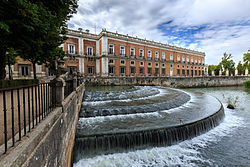Palacio Real (Aranjuez)
| Aranjuez cultural landscape | |
|---|---|
|
UNESCO world heritage |
|

|
|
| National territory: |
|
| Type: | Culture |
| Criteria : | ii, iv |
| Surface: | 2,048 ha |
| Reference No .: | 1044 |
| UNESCO region : | Europe and North America |
| History of enrollment | |
| Enrollment: | 2001 (session 25) |
The Palacio Real de Aranjuez ( Spanish for "Royal Palace of Aranjuez ") is a castle in the city of the same name in Spain , about 50 kilometers south of Madrid .
history
The castle was built over the remains of a monastery , the site of which was acquired by the Spanish king in the 16th century. Due to the attractive location at a bend of the Tagus , one of the summer residences of the royal family was built here in the following centuries , which was moved into every year in large relocation campaigns. The palace can look back on a long building history, during which it was repeatedly expanded and rebuilt.
Philip II gave the first construction contract to Juan Bautista de Toledo around 1560 , the further execution was taken over by Juan de Herrera , who also stood by the king's side during the construction of the monastery of El Escorial . When the construction work was completed, the castle was a four-wing Renaissance building around an inner courtyard, and in the years that followed, minor and major changes were made. Philip V had the palace converted into a large baroque residence and redecorated in the 18th century , and the palace park also got its current appearance at this time. Under Charles III. two more wings were finally added by 1778, which gave the palace its present form and together created a courtyard of honor , in front of which the oval palace square is located.
The palace has an elaborate interior design, the highlights are the porcelain salon , the throne room and the palace chapel, and the royal family's parade rooms and private living quarters have also been preserved in the palace . Since the palace partly houses a museum, it is open to visitors and forms the center of the city that is oriented towards it.
Gardens
Aranjuez Castle is famous for its park. The water forms the dominant design element due to the Tajo flowing directly past the palace. The main features of the baroque park have been preserved to this day and are divided into different areas, the prince's garden is located directly on the banks of the river, the island garden is on an artificially created island. The park is adorned with dozens of fountains, statues and flower beds; a small Chinese pavilion satisfied the need for exoticism.
In the park there is also the Casa del Labrador , a three-winged classicist pleasure palace , which was built for Charles IV until 1803 . Today the castle houses a large collection of porcelain and historical clocks.
useful information
The Palace of Aranjuez with its gardens and the city is on the UNESCO World Heritage List .
The famous opening scene from Schiller's Don Karlos takes place here.
The Puente de Barcas , which crossed the Tagus directly in front of the palace and was first established in 1656, was the first bridge accessible to the general public in Aranjuez, which is otherwise reserved for the court and its servants.
The palace complex inspired the Spanish composer Joaquín Rodrigo to compose his Concierto de Aranjuez in 1939 . When Rodrigo was raised to the hereditary Spanish nobility by King Juan Carlos I in 1991 , he received the title of Marqués de los Jardines de Aranjuez based on his composition .
gallery
See also
literature
- Juan A. Hernández Ferrero: Palacios reales del Patrimonio Nacional . Editorial Lunwerg, Barcelona 1997, ISBN 84-7120-218-2 .
- German translation: Spanish royal palaces. Evidence of a national history. Könemann, Cologne 1999, ISBN 3-8290-2231-X .
Web links
- Palacio Real de Aranjuez (Patrimonio Nacional) (in Spanish)
- The Palacio Real de Aranjuez as a 3D model in SketchUp's 3D warehouse
Coordinates: 40 ° 2 ′ 11 " N , 3 ° 36 ′ 32" W.




